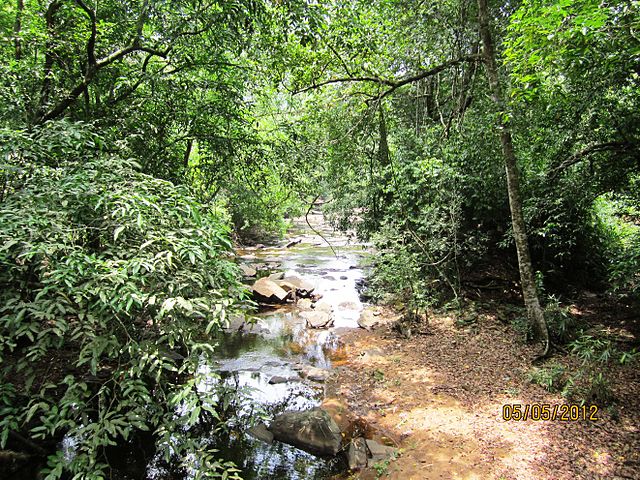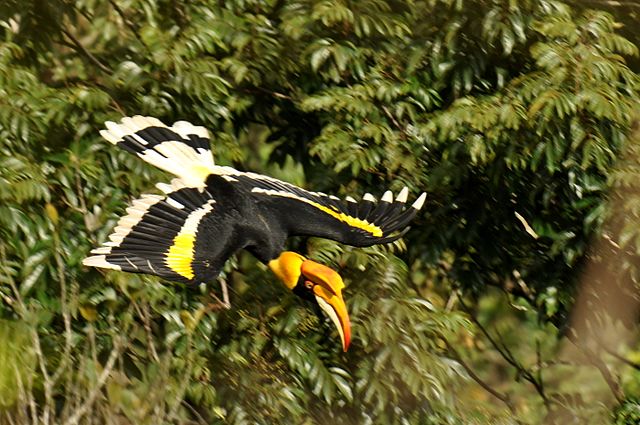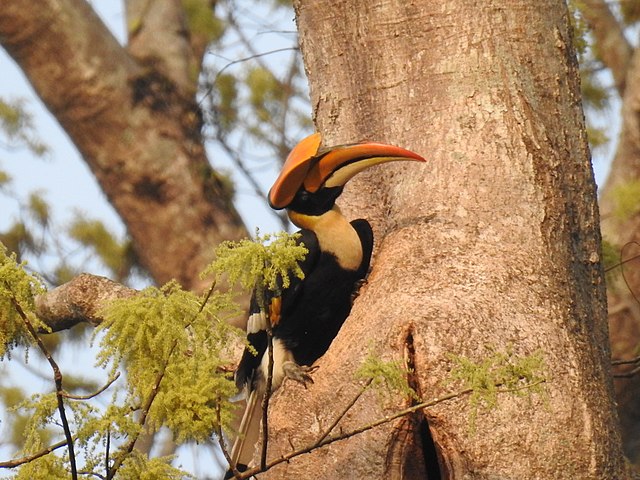Despite threats to their communities, the peaceful Kadar and four species of large birds, all hornbills, are beginning to thrive in southern Kerala where they live together in the forests. While numerous news reports over the years have chronicled the Kadar love for their natural environment, the critical development in recent years has been their growing involvement with forest protection and wildlife research. A lengthy news story posted in the Indian news website Scroll.in on December 30 reviewed the recent history of the Kadar and their work to protect the hornbills.

The Athirappilly Vazhachal forest of southern Kerala is the only place in India where four species of hornbills now live and breed. The great Indian hornbill (Buceros bicornis), Malabar pied hornbill (Anthracoceros coronatus), Indian grey hornbill (Ocyceros birostris), and Malabar grey hornbill (Ocyceros griseus) nest in the natural hollows that occur in giant forest trees. Although their huge bills prevent them from having binocular vision, their excellent hearing and sharp eyesight do keep them alert to human-caused disturbances on the forest floor. Disturbances have caused populations of hornbills to decline across India.
The news story last week credits the local Kadar for their efforts to protect the hornbills—and the forests in which they live. Senthil Kumar, a Kadar man, told the reporter that his people used to kill the big birds for their meat and gather their eggs from their nests. But in the past 20 years they have stopped doing that and they are now helping keep the nests and eggs of the birds safe.

His statement to the reporter was inspiring: “Our nine settlements of 174 families inside these forests had a dubious legacy as poachers and predators. But we are fast shrugging it off in our earnest bid to live in perfect harmony with nature and to safe keep these evergreen rainforests for future generations.”
The article in Scroll.in reports that only 1,848 Kadar now live in Kerala. Many of them take an active interest in their forests. Although the history of their opposition to the controversial Athirappilly Hydroelectric Dam project on the Chalakudy River has been covered in older news stories in this website, recent developments mentioned by the current article are worth noting.
About two years ago the traditional Kadar village meetings passed resolutions opposing the dam proposal. The resolution they passed invoked the Scheduled Tribes and Other Traditional Forest Dwellers Act of 2006. Reports claimed that those resolutions represented the first time that the law was invoked for the purpose of protecting a forest. The law stipulates that private or governmental projects can only be undertaken after local tribal meetings have approved them.

Ms. Geetha Vazhachal, the leader in one of the Kadar villages that would be affected by the proposed dam, told the reporter that if the Kerala State Electricity board did approve the construction of the dam despite the opposition from the Kadar, “the first casualty will be the region’s rich hornbill population.”
A lot of credit for inspiring the Kadar to become protectors of the hornbills should go to researcher K.H. Amitha Bachan. He has been affiliated with the Kerala Forest Department and the World Wildlife Fund-India Ecological Monitoring Programme. Most critically, he provided the leadership for organizing the Western Ghats Hornbill Foundation (WGHF).

The WGHF pioneered, along with the Kerala Forest Department, a project which induced Kadar young people to begin hornbill nest monitoring. At first, 72 Kadar youths were involved with helping the Forest Department protect known hornbill nest trees from poaching. The initiative started out by protecting 57 nests, though the number has expanded to 114 nests today. The Kadar activists also work with forestry personnel in planting trees and helping protect the forest from wildfires.
The foundation, which began in 1999 as a group of hornbill lovers, has evolved into a successful community-based conservation and research organization. It has conducted research on the hornbills and, while protecting the birds, it has also enhanced protection of the forest and the lives of the Kadar themselves. The young Kadar who work with the WGHF have gained training in monitoring techniques and protecting the big birds.
They are also trained to collect data and conduct scientific surveys. The foundation is aware of the value of the traditional forest knowledge of the Kadar in their work for science. “Through [the Kadar], we are in the process of developing a long-term monitoring system to assess changes in the rainforest and that is crucial for future conservation activities,” said one official who is involved with the foundation.

Another benefit for the Kadar is the steady income that the people employed in the forest protection work gain. A previous source of income was menial work in the eateries and shops located near the Athirappilly waterfalls on the Chalakudy River, a major destination for tourists in southern Kerala.
In Mr. Bachan’s opinion, protecting and enhancing the forest serves to promote both the Kadars and the hornbills. They are equally important and interlinked. “No conservation would be possible without cooperation of the local community, especially the aborigines. Integrating their traditional wisdom with [a] modern-day scientific approach would definitely yield results,” he said.
He emphasized the importance of treating the Kadar employees as equals working toward the goal of protecting the ecosystem. They require as much attention as animals, birds, and trees in the forest. He said that the economic boost the Kadars gain from their employment plays an essential role in converting them into protectors of the hornbills and the rest of the natural world.